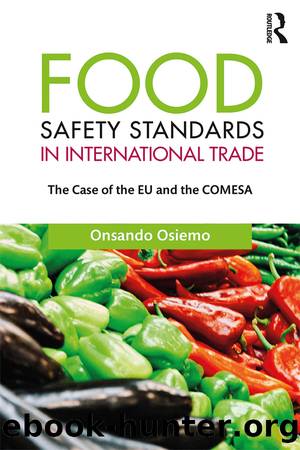Food Safety Standards in International Trade by Osiemo Onsando;

Author:Osiemo, Onsando; [Onsando Osiemo]
Language: eng
Format: epub
ISBN: 9781315526584
Publisher: Taylor and Francis
46 UNCTAD (n 37) 30-33. See also Mauro Gioe, ‘Can Horticultural Production Help African Smallholders to Escape Dependence on Export of Tropical Agricultural Commodities?’ (2006) 6 (2) Crossroads 16, 24. According to the author, from 1980 to 2000, world prices for 18 major export commodities fell by more than 25 per cent in real terms. The decline was especially steep for cotton (47 per cent), coffee (64 per cent), rice (61 per cent), cocoa (71 per cent), and sugar (77 per cent).
47 COMESA Treaty, arts 3-4.
48 United Nations Economic Commission for Africa (UNECA), ‘Assessing Regional Integration in Africa’ (UNECA Policy Research Report, 2004) 83. See also: Padamja Khandelwa, ‘COMESA and SADC: Prospects and Challenges for Regional Trade Integration’ (IMF Working Paper, WP/04/227, 2004) 34. The author concludes that prospects for expansion of intra-regional trade might be limited due to the low levels of intra-regional trade and product complementarities. The author notes that exports of Eastern and Southern African countries are concentrated in a few primary commodities; Anna M Mayda and Chad Steinberg, ‘Do South-South Trade Agreements Increase Trade? Commodity-Level Evidence from COMESA’ (2009) 42 Canadian Journal of Economics 1361. In a study of the static effects of COMESA on Uganda’s trade, the authors find minimal trade creation and trade diversion effects. The authors surmise that South-South PTAs, because member countries are not natural trading partners, are unlikely to produce substantial increases in trade volumes.
49 COMESA Treaty, arts 99–105.
50 Colin McCarthy, ‘Is African Economic Integration in Need of a Paradigm Change? Thinking out of the Box on African Integration’ in Anton Bosl and others (eds) Monitoring the Process of Regional Integration in Southern Africa Yearbook (Trade Law Centre for Southern Africa (Tralac), Vol. 7, 2007) 6, 16–18. The author argues that the typical African integration community does not meet the requirements of the static welfare effect of trade creation: ‘A group of neighbouring commodity-producing economies and limited industrial capacity to produce tradable goods hardly meets the conditions for realizing the welfare benefits of trade creation’. However, the author goes on to argue that seeking static welfare effects has never been part of the post-colonial African regional integration agenda. Instead, the rationale has exclusively been to achieve the dynamic advantages of integration: economies of scale, resulting in competition among producers and inward investment flows, both internal and external. The sole aim of integration was to catch up with the developed world.
51 COMESA Treaty, art 3 (a) (b).
52 United Nations, ‘United Nations Millennium Declaration’ (General Assembly, 8th Plenary Meeting, 8 September 2000, A/RES/55/2). The declaration resolved to halve poverty by the year 2015, among other goals.
53 The World Bank, ‘World Development Report 2008: Agriculture for Development’ (The World Bank, Washington, DC, 2007) 1–26.
54 For further analysis, see World Trade Organization (WTO), ‘World Trade Report 2014: Trade and Development: Recent Trends and the Role of the WTO’ (WTO Geneva, Switzerland, 2015) 135–145.
55 COMESA Treaty, art 132 (d).
56 COMESA appears to be pursuing its SPS issues under the umbrella of promoting agricultural marketing. Food safety is seen as a component of this wider strategy and not an independent issue.
Download
This site does not store any files on its server. We only index and link to content provided by other sites. Please contact the content providers to delete copyright contents if any and email us, we'll remove relevant links or contents immediately.
The Thirst by Nesbo Jo(5784)
Permanent Record by Edward Snowden(4996)
The Myth of the Strong Leader by Archie Brown(4789)
Spare by Prince Harry The Duke of Sussex(4195)
A Higher Loyalty: Truth, Lies, and Leadership by James Comey(4032)
Secrecy World by Jake Bernstein(3782)
Adulting by Kelly Williams Brown(3668)
The Borden Murders by Sarah Miller(3590)
Fear by Bob Woodward(3260)
Killers of the Flower Moon by David Grann(3235)
The Last Girl by Nadia Murad(3054)
The Secret Barrister by The Secret Barrister(3008)
Future Crimes by Marc Goodman(3002)
American Kingpin by Nick Bilton(2970)
Liar's Poker by Michael Lewis(2810)
The House on Mango Street by Sandra Cisneros(2777)
Graduate Admissions Essays, Fourth Edition: Write Your Way into the Graduate School of Your Choice (Graduate Admissions Essays: Write Your Way Into the) by Asher Donald(2474)
Delicious Torment by Linsey Lanier(2447)
Camino Island by John Grisham(2383)
